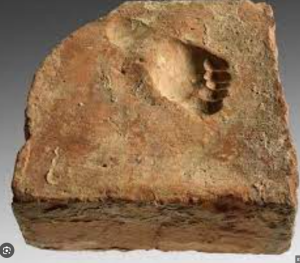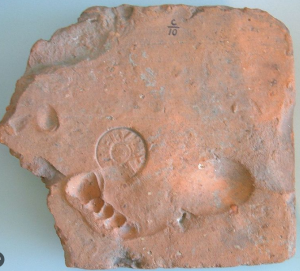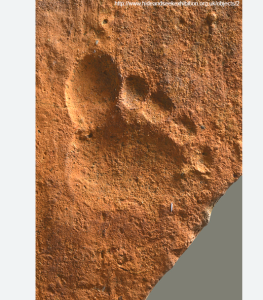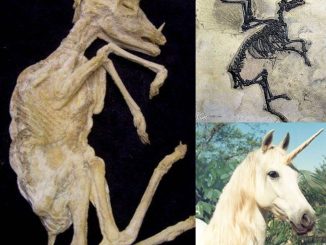A Moment Captured for Eternity
In the charming commune of Vaison-la-Romaine, known in ancient times as Vasio Vocontiorum, a remarkable discovery brings the distant past to life with a touch of endearing humanity. Nestled within this historical site, known for its rich Roman heritage, lies a red clay tile bearing the footprint of a toddler, imprinted as it dried around 2000 years ago. This simple yet profound artifact offers a fleeting glimpse into the everyday life of the Roman world, bridging the gap between our modern lives and those of ancient times.

An Accidental Legacy
The red clay tile with the toddler’s footprint is an artifact that speaks volumes, despite its simplicity. Likely left unintentionally, the footprint immortalizes a moment of curiosity or play, transforming an ordinary object into a portal to the past. This small, ephemeral act, preserved through millennia, allows us to connect with a child’s presence in a world vastly different from our own yet filled with similar moments of innocence and discovery.
The images of the tile provided showcase not only the clear imprint of a small foot but also the texture of the clay and the craftsmanship involved in creating such everyday items in ancient Rome. The juxtaposition of a child’s spontaneous act against the backdrop of Roman society emphasizes the universality of human experience, reminding us that history is made up of individual lives and moments just like our own.

Vaison-la-Romaine: A Window into the Roman World
Vaison-la-Romaine, or ancient Vasio Vocontiorum, is a site of immense historical significance, offering insights into Roman architecture, culture, and daily life. The discovery of the toddler’s footprint in this context adds a personal dimension to our understanding of the past, serving as a tangible link to the individuals who once inhabited this space. This ancient town, with its ruins and relics, serves as a testament to the Roman Empire’s vast reach and the intricate tapestry of lives that contributed to its legacy.
Exploring Vaison-la-Romaine and its discoveries, including the tile with the footprint, enriches our appreciation for the continuity of human history. The images invite viewers to imagine walking through the same streets where a Roman child once roamed, connecting us across time through the shared experience of simply living.

Reflections on Time and Memory
The imprint of a toddler’s foot in a drying clay tile from approximately 2000 years ago is more than just an archaeological curiosity; it’s a poignant reminder of the fleeting nature of life and the enduring power of memory. As we delve into ancient discoveries, we uncover not only artifacts and ruins but also the echoes of past lives that resonate with our own experiences and emotions.
This singular footprint, preserved by chance, encourages us to reflect on the layers of history beneath our feet and the interconnectedness of human stories through time. It challenges us to consider what legacies we leave behind and how seemingly insignificant moments can capture the essence of our shared humanity.
In conclusion, the discovery of a Roman toddler’s footprint in Vaison-la-Romaine offers a unique and deeply human perspective on the ancient world. This small but significant artifact reminds us that history is not only about empires and events but also about the daily lives and accidental moments that define our shared human experience. As we continue to explore and uncover the remnants of the past, we are reminded of the enduring traces we all leave on the fabric of time.

This simple yet profound artifact encourages us to explore further, to uncover the stories hidden within the most ordinary objects and moments from the past. As we delve into ancient discoveries, we are reminded of the depth and richness of human history, a tapestry woven from both the monumental and the mundane. In the end, it is these small, personal narratives that truly bring the past to life, allowing us to step through time and connect with those who walked before us.


